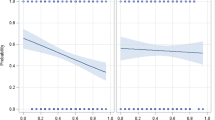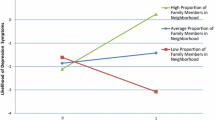Abstract
A continuing debate in sociological criminology involves the association of crime with economic disadvantage at both aggregate and individual levels of analysis. At the aggregate level, data from law enforcement sources suggest that rates of intimate violence are higher in disadvantaged neighborhoods. Disadvantaged neighborhoods may experience higher rates of intimate violence for compositional or contextual reasons, or rates may only appear to be higher because of differential reporting. Similarly, at the individual level, intimate violence appears more common among couples that are economically distressed, but whether economic distress triggers intimate violence is not certain. Using data from waves 1 and 2 of the National Survey of Families and Households and from the 1990 U.S. Census, we investigate the effects of neighborhood economic disadvantage and individual economic distress on intimate violence against women. Controlling for violence at time 1 and other individual level characteristics, we find that neighborhood economic disadvantage, neighborhood residential instability, male employment instability, and subjective financial strain influence the likelihood of violence at time 2. The relationship between neighborhood disadvantage and intimate violence appears to reflect both compositional and contextual effects.
Similar content being viewed by others
REFERENCES
Agnew, R. (1992). Foundation for a general strain theory of crime and delinquency. Criminology 30:47-88.
Babcock, J. C., Waltz, J., Jacobson, N. S., and Gottman, J. M. (1993). Power and violence: The relation between communication patterns, power discrepancies, and domestic violence. J. Consult. Clin. Psychol. 61:40-50.
Burgess, R. L., and Draper, P. (1989). The explanation of family violence: The role of biological, behavioral, and cultural selection. In Ohlin, L., and Tonry, M. (eds.), Family Violence, University of Chicago Press, Chicago, pp. 59-116.
Bursik, R. J. (1988). Social disorganization and theories of crime and delinquency: Problems and prospects. Criminology 26:519-551.
Bursik, R. J., and Webb, J. (1982). Community change and patterns of delinquency. Am. J. Sociol. 88:24-42.
Byrne, J. M., and Sampson, R. J. (1986). The Social Ecology of Crime, Springer-Verlag, New York.
Cascardi, M., Langhinrichsen, J., and Vivian, D. (1992). Marital aggression: Impact, injury, and health correlates for husbands and wives. Arch. Intern. Med. 152:1178-1184.
Conger, R. D., Elder, G. H., Jr., Lorenz, F. O., Conger, K. J., Simons, R. L., Whitbeck, L. B., et al. (1990). Linking economic hardship to marital quality and instability. J. Marriage Fam. 52:643-656.
DeMaris, A. (2000). 'Till discord do us part: The role of physical and verbal conflict in union disruption. J. Marriage Fam. 62:683-692.
Fagan, J., and Browne, A. (1994). Violence between spouses and intimates: Physical aggression between men and women in intimate relationships. In: Reiss, A. J., Jr., and Roth, J. A. (eds.), Understanding and Preventing Violence, National Academy Press, Washington, DC, pp. 115-292.
Farley, R. (1996). The New American Reality: Who We Are, How We Got Here, Where We Are Going, Russell Sage Foundation, New York.
Fox, G. L., and Chancey, D. (1998). Sources of economic distress: Individual and family outcomes. J. Fam. Issues 19:725-749.
Furstenberg, F. F., Jr., and Hughes, M. E. (1997). The influence of neighborhood on children's development: A theoretical perspective and research agenda. In: Brooks-Gunn, J., Duncan, G. J., and Aber, J. L. (eds.), Neighborhood Poverty: Policy Implications in Studying Neighborhoods, Russell Sage Foundation, New York, pp. 23-47.
Gaquin, D. (1977–1978). Spouse abuse: Data from the national crime survey. Victimology 2:634-643.
Gephart, M. A. (1997). Neighborhoods and communities as contexts for development. In: Brooks-Gunn, J., Duncan, G. J., and Aber, J. L. (eds.), Neighborhood Poverty: Context and Consequences for Children, Russell Sage Foundation, New York, pp. 1-43.
Gottfredson, M. R., and Hirschi, T. (1990). A General Theory of Crime, Stanford University Press, Stanford, CA.
Greenberg, S., Rohe, W. M., and Williams, J. R. (1982). Safe and Secure Neighborhoods:Physical Characteristics and Informal Territorial Control in High and Low Crime Neighborhoods, National Institute of Justice, Washington, DC.
Greenfeld, L. A., Rand, M. R., Craven, D., Klaus, P. A., Perkins, C., Warchol, G. et al. (1998). Violence by Intimates: Analysis of Data on Crimes by Current or Former Spouses, Boyfriends, and Girlfriends, U. S. Department of Justice, Washington, DC.
Grodzins, M. (1960). The Metropolitan Area as a Racial Problem, University of Pittsburg Press, Pittsburg.
Hagan, J. (1993). The social embeddedness of crime and unemployment. Criminology 31:465-492.
Hampton, R. L., and Gelles, R. J. (1994). Violence toward black women in a nationally representative sample of black families. J. Comp. Fam. Stud. 25:105-119.
Harris, D. R. (1999). “Property values drop when blacks move in, because...”: Racial and socioeconomic determinants of neighborhood desirability. Am. Sociol. Rev. 64:461-479.
Hosmer, D. W., and Lemeshow, S. (1989). Applied Logistic Regression, John Wiley & Sons, New York.
Kornhauser, R. D. (1978). Social Sources of Delinquency, University of Chicago Press, Chicago.
Lauritsen, J., and White, N. A. (2001). Putting violence in its place: The influence of race, ethnicity, gender, and place on the risk for violence. Criminol. Public Policy 1:37-60.
Lockhart, L. L. (1987). A reexamination of the effects of race and social class on the incidence of marital violence: A search for reliable differences. J. Marriage Fam. 49:603-610.
MacMillan, R., and Gartner, R. (1999). When she brings home the bacon: Labor-force participation and the risk of spousal violence against women. J. Marriage Fam. 61:947-958.
Miethe, T. D., and McDowall, D. (1993). Contextual effects in models of criminal victimization. Soc. Forces 71:741-759.
Miles-Doan, R. (1998). Violence between spouses and intimates: Does neighborhood context matter. Soc. Forces 77:623-645.
Moffitt, T. E., Krueger, R. F., Caspi, A., and Fagan, J. (2000). Partner abuse and general crime:How are they the same? How are they different? Criminology 38:199-232.
Morse, B. J. (1995). Beyond the conflict tactics scale: Assessing gender differences in partner violence. Violence Vict. 10:251-272.
Reiss, A. J., Jr. (1986). Why are communities important in understanding crime? In: Reiss, A. J., Jr., and Tonry, M. (eds.), Communities and Crime, University of Chicago Press, Chicago, pp. 1-34.
Robert, S. A. (1999). Socioeconomic position and health: The independent contribution of community socioeconomic context. Annu. Rev. Sociol. 25:489-516.
Ross, C. E., Reynolds, J. R., and Geis, K. J. (2000). The contingent meaning of neighborhood stability for residents' psychological well-being. Am. Sociol. Rev. 65:581-597.
Sampson, R. J. (1985). Neighborhood and crime: The structural determinants of personal victimization. J. Res. Crime Delinq. 22:7-40.
Sampson, R. J. (1986a). Crime in cities: The effects of formal and informal social control. In: Reiss, A. J., Jr., and Tonry, M. (eds.), Communities and Crime, University of Chicago Press, Chicago, pp. 271-312.
Sampson, R. J. (1986b). Neighborhood family structure and the risk of personal victimization. In: Byrne, J. M., and Sampson, R. (eds.), The Social Ecology of Crime, Springer-Verlag, New York, pp. 25-46.
Sampson, R. J. (1993). Family and community-level influences on crime: A contextual theory and strategies for research testing. In: Farrington, D. P., Sampson, R. J., and Wikstrom, P. H. (eds.), Integrating Individual and Ecological Aspects of Crime, National Council for Crime Prevention, Stockholm, Sweden, pp. 153-168.
Sampson, R. J., and Groves, W. B. (1989). Community structure and crime: Testing social disorganization theory. Am. J. Sociol. 94:774-802.
Sampson, R. J., Morenoff, J. D., and Earls, F. (1999). Beyond social capital: Spatial dynamics of collective efficacy for children. Am. Sociol. Rev. 64:633-660.
Sampson, R. J., and Raudenbush, S. W. (1999). Systematic social observation of public spaces: A new look at disorder in urban neighborhoods. Am. J. Sociol. 105:603-651.
Sampson, R. J., Raudenbush, S. W., and Earls, F. (1997). Neighborhoods and violent crime: A multilevel study of collective efficacy. Science 277:918-924.
Sampson, R. J., and Wilson, W. J. (1995). Toward a theory of race, crime, and urban inequality. In: Hagan, J., and Peterson, R. D. (eds.), Crime and Inequality, Stanford University Press, Stanford, CA, pp. 37-54.
Shaw, C., and McKay, H. (1942). Juvenile Delinquency and Urban Areas, University of Chicago Press, Chicago.
Sherman, L. W., and Berk, R. A. (1984). The specific deterrent effects of arrest for domestic assault. Am. Sociol. Rev. 49:261-272.
Simcha-Fagan, O., and Schwartz, J. E. (1986). Neighborhood and delinquency: An assessment of contextual effects. Criminology 24:667-704.
South, S. J., and Crowder, K. D. (1999). Neighborhood effects on family formation:Concentrated poverty and beyond. Am. Sociol. Rev. 64:113-132.
Stark, R. (1987). Deviant places: A theory of the ecology of crime. Criminology 25:893-909.
Stets, J. E. (1991). Cohabiting and marital aggression: The role of social isolation. J. Marriage Fam. 53:669-680.
Straus, M. A., Gelles, R. A., and Steinmetz, S. K. (1980). Behind Closed Doors: Violence in the American Family, Doubleday, Garden City, NY.
Sugarman, D. B., and Hotaling, G. T. (1989). Violent men in intimate relationships: An analysis of risk markers. J. Appl. Soc. Psychol. 19:1034-1048.
Sweet, J. A., Bumpass, L. L., and Call, V. (1988). The Design and Content of the National Survey of Families and Households. NSFH Working Paper #1.
Szinovacz, M. E., and Egley, L. C. (1995). Comparing one-partner and couple data on sensitive marital behaviors: The case of marital violence. J. Marriage Fam. 57:995-1010.
Tjaden, P., and Thoennes, N. (1998). Prevalence, Incidence, and Consequences of Violence Against Women: Findings From the National Violence Against Women Survey, Research in Brief, National Institute of Justice and Centers for Disease Control and Prevention, Washington, DC.
U. S. Census Bureau (1995). Poverty Areas 1–4, U. S. Census Bureau, Washington, DC.
U. S. Department of Justice (1996). Criminal Victimization in the United States, U. S. Department of Justice, Washington, DC.
Voydanoff, P. (1990). Economic distress and family relations: A review of the eighties. J. Marriage Fam. 52:1099-1115.
Voydanoff, P., and Donnelly, B. W. (1988). Economic distress, family coping, and quality of family life. In: Voydanoff, P., and Majka, L. (eds.), Families and Economic Distress, Sage Publications, Newbury Park, CA
Warner, B. D., and Pierce, G. L. (1993). Reexamining social disorganization theory using calls to the police as a measure of crime. Criminology 31:493-518.
Wilson, J. Q., and Herrnstein, R. J. (1985). Crime and Human Nature, Simon and Schuster, New York.
Wilson, W. J. (1987). The Truly Disadvantaged, University of Chicago Press, Chicago.
Wilson, W. J., Aponte, R., Kirschenman, J., and Wacquant, L. (1988). The ghetto underclass and the changing structure of American poverty. In: Harris F., and Wilkins R. W. (eds.), Quiet Riots: Race and Poverty in the United States, Pantheon, New York, pp. 123-154.
Author information
Authors and Affiliations
Rights and permissions
About this article
Cite this article
Benson, M.L., Fox, G.L., DeMaris, A. et al. Neighborhood Disadvantage, Individual Economic Distress and Violence Against Women in Intimate Relationships. Journal of Quantitative Criminology 19, 207–235 (2003). https://doi.org/10.1023/A:1024930208331
Issue Date:
DOI: https://doi.org/10.1023/A:1024930208331




